
Poster or cartoon. Credit: LHS archives
This account draws on correspondence, official notices and many press cuttings in our archives. (RB 89) We hope it will attract comments and additions from those who were billeted here and returned home, and from those who settled in Harpenden after the War or who were members of hosting families.
The Government’s Evacuation Scheme
On 6 January 1939 the Ministry of Health published the text of a broadcast by Mr Walter Elliott on “The Transfer of Population in Time of War”, with plans to ensure the safety of children, including the one million children in London.
“To organise this, it is clear we have to look for homes for the children mainly in houses where people already are. Empty houses and camps will be used as far as possible. …..Schools will be moved as units with their teachers who will continue with their education. These school children will need both board and lodging. …. We have to see not only that the houses for instance are suitable for the children, but that the children are suitable for the homes. We want this to be a matter of real human relationship – a willing host and a willing guest.”
Local authorities were asked to make a survey of housing accommodation by the end of February. The appeal concluded with: “… one of the foundations of any nation is that it has thought of danger, faced danger, and decided on action, so that in danger it may be secure.”

Survey of accommodation in Harpenden, February 1939. Credit: LHS archives – RB 89
Planning for Harpenden – January to August 1939

Handbill for WVS meeting. Credit: LHS archives – RB 89
The first step was for the Women’s Voluntary Services for Civil Defence for Hertfordshire to write to all local authorities offering the service of a WVS Evacuation representative in their area to assist with the survey. For Harpenden this was Mrs Joan Fryer who liaised with the Clerk of Harpenden Urban District Council, Mr Frederick A Harris. Letters were sent to householders by the Chairman of the Council Ronald G Taylor and the Clerk alerting them to the house-to-house survey. A Public Meeting was held in the Public Hall on 20 February.
Mrs Fryer reported in March that since January the WVS had enrolled 365 women to ARP services, Transport, Hospital Services and Supplies and Evacuation Services. Concerning Evacuation she reported: “A card index has been made of all billeters. These have been grouped in roads and on each billeter’s card it is stated what type of child or grown up … boy or girl, the age preferred, mother or teacher. … a list of all those requiring blankets and mattresses has been made … lists of volunteers willing to help with the reception of children, canteen and clerical helpers have been given to the Evacuation Officer, (Mrs H J Raban). A list of cars available to take children and bedding to billets has also been compiled. … Our next job is to make lists of all those households who need help or communal feeding.”
The WVS, who soon became known as the ‘Women in Green’, had an office in a small room at the Harpenden Hall and on 25 February they asked for a telephone to be installed and to have a permanent typewriter instead of a borrowed one – but the Clerk to the Council replied that the Committee “do not feel they can recommend the Council to fix a telephone extension in your office” because it was not known if the WVS would be permanently established in each district. .
Plans ready to receive 2,100 evacuees
By 14 April, plans were being made for a total number of 2,100 evacuees arriving over three days, 700 at a time arriving by train from St Pancras. Buses would meet the evacuees at Harpenden Station to take them to their billets –
- 20% to Batford,
- 10% to The Harrow, Kinsbourne Green,
- 20% to South Harpenden;
- 20% to the (railway) Arch, Luton Road
- and 30% would walk.
One adult would be in charge of ten children who would be carrying a change of clothes if possible and also their own gas masks. There would be no blankets: these would arrive later (in mid July) and would be stored in the Pump House at the Waterworks in Shakespeare Road. Medical examinations were to be arranged if possible, but due to the large numbers, this was not considered feasible in the short time between each day’s arrivals.
In June there was a follow up letter to 250 households who had said they could not billet owing to ill-health etc., pointing out that a doctor’s certificate was needed for exemption to be registered. And there were occasional letters to the local press implying that some well-to-do householders might be evading their share of responsibility (Harpenden Gleanings, 20 October 1939).
Final plans and instructions
The Minutes of the meeting of Billeters held on 4 July 1939 in the old Public Hall (now Park Hall), chaired by Mrs Raban, provide final details for the plans for meeting the evacuees, together with instructions to the Billeters about issuing the forms enabling householders to draw the government’s allowances for those they host.
“Under Form B the householders can draw 5/- per head per week for mothers and adults, to cover shelter and water supply only, but not food; and 3/- per head per week for children under school age. Under Form A the householders can draw 10/6 per week for one unaccompanied child and 8/6 if more than one is taken; this is to cover food, washing etc. and shelter, but not clothing or medical expenses, arrangements for which have been made, and the responsibility will not fall upon the householder. A Tribunal would be set up in Harpenden to deal with any complaints on the part of the householders or the evacuees.”
The WVS would assist the Billeters in any way. At the end of the meeting the Billeters divided up according to their sectors to discuss which roads they would be responsible for – see schedule of ARP Sectors, Districts and Volunteers. ((p61-62)
Plans turned into Action – September 1939

Plan for reception of evacuees. Credit: LHS archives – RB 89
The Evacuees started arriving by train on Friday, 1 September 1939 and again on the Saturday. The train was cancelled on Sunday, 3 September, when war was declared at 11am, but some 1,300 women and children arrived by double-decker bus from Enfield, giving a total of 2,400 over the weekend. Fifty-three billets were offered for expectant mothers arriving on Sunday, 3 September.
There was a plan to send 1,800 blind people to Hertfordshire, but after protest at the lack of warning and provision for them this was revised down to 200 and again down to 100. In the end, Harpenden had 5 out of the 100 instead of the 200 originally due to come. Mr Catton of “The Ridge”, Luton Road, took 20 handicapped children along with two or three adult helpers. Empty property was taken over for evacuees, as at 18 Clarence Road, in September 1939.
Evacuee Hostels and Clinics
An Evacuees Boys Hostel was set up at 20 Hollybush Lane: this was also known as the Welfare Centre. Another hostel for families was set up at 2 Arden Grove in August 1940. At first there was a lady from Enfield with two children, and another with ten children. At times the running of this hostel gave cause for concern, and there were several changes of staff to try to put matters right. It was closed for a while and reopened in March 1941, eventually closing on 4 February 1945.
For younger children the Harpenden Montessori House Ltd in Sun Lane, by St George’s School, had closed on 2nd August 1940 and reopened on 3rd October as The Edmonton Day Nursery. It was closed in July 1943 and reopened with its former owners on 7th September 1943. Miss E Stephenson was the Matron in 1941.
The Rector’s Room on Church Green and the Methodist Church Hall had been taken over on 12 August 1939 for educational purposes. However on 8 December 1942 the Methodist Hall became a War-Time Nursery. Opening in October 1939, 13 Salisbury Avenue housed St Martin’s Lodge Sick Bay for Evacuated Children. The hostel was managed by Mrs Falkner on behalf of the County Council. The WVS helped by providing volunteers to do elementary nursing and general care of the children, reading stories and taking them for walks. In January 1943 Mrs Mardall, the WVS leader, was appealing for help at the hostel, which finally closed on 31 May 1945.
In July 1943 Harpenden Urban District Council presented badges, awarded by the Ministry of Health, for good service to Wardens of local hostels for evacuees. Recipients were:
- Mr and Mrs G H Bouncey of 20 Hollybush Lane
- The Misses Leah and Webb of 2 Arden Grove (NB check names in Kelly’s)
- And Mrs Lewis of Bramble Corner, Devonshire Road.
Bowers Parade shops had been built in 1936, but several remained empty in 1939. No. 5 was taken over by the Council and an Evacuee Clinic was set up as from 1 September. It was staffed by helpers from the Red Cross and dealt with cuts and minor injuries. In July 1940 wire netting was fitted to the windows as blast protection. In February 1943 there was some debate as to whether this was still needed, but it was retained due to the worsening situation in Europe, which might lead to another influx of evacuees. However it finally closed on 11 December 1943.
The nurse responsible for the evacuated schools was recalled to London in March 1943, leaving the District Nurses in Harpenden with even more to do. They were not able to visit the schools as often as desired, but were hoping to arrange a central clinic, possibly at Manland School.
Mr Nelson Davis led a team of volunteers running the Hospital Car Service, taking evacuees between hostels and medical services, for which they claimed petrol expenses, and were usually paid in food tokens – (Scan of Mabel Farmer’s letter of 16 Oct 1939 p.58)
Schooling
The pupils and staff of three London County Council schools – Hugh Myddleton from Clerkenwell, Crondall Street from Shoreditch, and Medburn School from Somerstown – all transferred to Harpenden. But there was soon confusion, as a directive was issued that all schools were to close until reasonable protection against air raids could be given.
There was also some local dissatisfaction about sharing school premises with local children according to a Free Press report on 3 November 1939: “Parents are ‘up in arms’ because of the order recently issued at the County Hall in Hertford introducing an alternate week system at the Harpenden Manland Schools, whereby the local children change and change about with the evacuees and, every other week, have to go so school on Tuesday, Thursday and Saturday morning.” It was reported that Mr C F Putterill, Chairman of the Local Education Committee was taking this up with the Director of Education Committee to discuss a new plan. (p.65) A system was evolved making use of all available church halls, and the old Victoria Road School – then empty, having been condemned as unfit for use! (The pupils had moved from there to Manland Junior and Senior Schools just before the outbreak of war).
The Crondall Street School was billeted in North Harpenden and used the Church Hall at Kinsbourne Green along with the local children – later merged into St Mary’s School. Meanwhile, Manland Senior School took in the Hugh Myddleton children and staff. Enough Medburn Street children stayed throughout the war to enable Victoria Road School to stay open until June 1945. There is also indication that the Coldharbour Lane Mission Church Hall was also used as a school from 10 June 1940.
It was expected that the bombing of London would start right from the beginning of the War, but this did not happen, with the result that many children returned to London, either to see family, or to go home to stay. In December 1939 there were 836 children at school and in January 1940 it was noticed that numbers were dropping and by 10 February numbers were down to 719. A notice in the Free Press gave warning that some re-billeting would be needed. A Government minister was later heard to say of the evacuation, that if it were ever to be done again, they would transfer people much further away, as it was easy to return to London when they were only a short distance away.
250 children came from Hastings in July 1940 and were divided between St Nicholas Church School and High Street Methodist Church Hall, working as separate units, but by mid 1942 their numbers had dropped to 25 and they merged with St Nicholas School. This influx of children gave the headmaster of St Nicholas School problems with feeding so many that he asked for a canteen to be set up. There was some delay, but he did get one, called the Dinner Club, which was opened on 23 January 1941. It served meals to 125 children – 57 local and 68 evacuees.
Town v. countryside
The two different lifestyles of the children from Harpenden and those from London clashed at times, both sides being unsure of the other. In a letter to the Free Press on 17 May 1940 Mr Robert Beckwith of Marquis Lane explained to the children how they should behave while in the countryside:
“There is a large amount of bird-nest rifling going on – I actually saw some boys take a thrush’s nest away, complete with three eggs. … Then there is the wanton picking and destruction of wild flowers: cannot children be told that it is harmful, besides being wretchedly selfish, to pick bunches of flowers far beyond their needs …. What is perhaps sadly needed is some organised walking parties in charge of some person who understands the countryside, the farmer’s point of view and the nature and usefulness of much of the wild life and flowers which abound in Harpenden.” (RB.Evacuees, p.67)
Writing in his memoirs, The Land Called Me (p.261), the Director of Rothamsted, Sir John Russell, wrote: “A flood of refugees came to Harpenden and we took into our house a woman from North-East London and her two children. But they could not stand the quietness, the lack of fried fish shops and similar amenities, and went back as soon as they thought it safe. Then, too, Harpenden people learnt with amazement how utterly ignorant many of the children were of the most elementary notions of religion, conduct and manners, and how completely they lacked house training, so that we wondered what London school teachers had been doing all those years.”
Visits from parents
The parents of the children would visit them on Sundays and in some cases expected the host family to feed them as well as their children – this becoming a sore point with some people. To overcome this, Mr Jesse Catton gave the use of two empty shop units in Broadway Hall (the site of Sainsbury’s since 1970) in the High Street, where a Sunday Café was provided from October 1939 to overcome the problems.
Harpenden Gleanings (20 October 1939) reported that the first Harpenden Rover Scouts under the leadership of Mr D.E. Sanders were responsible for the arrangements, providing hospitality for the Sunday trippers – “Several spoke very appreciatively of the arrangements. One man said: ‘We did not expect to get nice stuff like this at reasonable prices, in fact we expected to be rooked in Harpenden!” However this canteen was short-lived as Broadway Hall was later taken over by the Council on behalf of the War Department at the end of September 1940.

Thank you letter from the headmaster of Hugh Myddleton School. Credit: LHS archives – RB 89.
Writing from his billet at 35 Ox Lane on 5 September 1939, William S Brown, Headmaster of Hugh Myddleton Central School wrote to the Officer-in-charge of Evacuation:
“Dear Sir, I am taking the first opportunity at this busy time, to send to you and all your staff of helpers, our heartfelt appreciation and our sincerest thanks for the splendid way in which our detachment from the Hugh Myddleton Central School was received and billeted on Saturday last. The warmth of our welcome, and especially the kind forethought which was evident in all the arrangements for the comfort of the children was almost overwhelming. The splendid organisation we knew of. It was the kindly human element which touched us profoundly, and I do wish to express our thanks, mine and those of the whole staff, to all your workers, down to the last boy scout. We shall never forget our reception, and I trust that the school will show its appreciation by its manner of life in its new home. We shall all work untiringly to this end, and we hope you will count on us and call on us.” (or scan – p.53)
Misdemeanours
By January 1940 it was the fourth time that eight schoolboy evacuees from Enfield were in court. On arrival in Harpenden they had formed a gang known as “The Crooning Gang” and were said to be involved in ten cases of theft from Harpenden shops. The one who stole the most would be the leader. It was said that the “brains” of the gang had slipped through the hands of the Police. The leader and his second in command were said to be backward in their educational attainment and were being kept at a remedial home for examination at a psychiatric clinic. The Probation Officer, Mr W Broadfield, presented medical reports concerning both boys and the Justices decided to send them to an approved school. The remaining six boys were placed on probation.
On 10 January 1941 six evacuee children were in Court for petty theft. All six were placed on probation. They stole articles from a bicycle shop, a lamp from a cycle at the Railway Station, cigarettes from the Austral Cinema in Luton Road and leggings and a cape from a cycle left in the cinema car park. It was said they had money to buy what they wanted, but preferred to steal. The people they were billeted with spoke well of them.
A ten-year-old boy, again from London, was before St Albans Juvenile Court in July 1941 for stealing a bicycle from outside the Methodist Sunday School. It was returned after ten days when he was seen riding it in Crabtree Lane. The Chairman of the Court, Mr M G Dashwood, said: “We understand that there has been a great deal of this sort of thing going on in Harpenden and around generally. It has got to be stopped, and if it cannot be stopped by the way we are dealing with this boy, we shall have to take more stringent steps with anybody else caught doing this.” He was placed on probation for two years, the Probation Officer being Miss Rayham. The boys’ teacher said the people whom he was billeted with had not acted right.
Entertainment
To provide entertainment the Harpenden Drama League put on “Toad of Toad Hall” for a week in January 1940. So many people wanted to attend that over 200 children could not get tickets. To solve the problem an extra special Matinee was put on at 10 am on Saturday, 13 January to accommodate them all.
In August 1941, the St Nicholas branch of the Mother’s Union invited fourteen mothers from Limehouse to a meeting in Harpenden. They visited the Common, attended a short service in the Parish Church and were entertained to tea and refreshment at the Rectory. They enjoyed games and competitions, for which prizes were awarded, in the Rectory gardens.
The Free Press announced in November 1941 that Victoria Road School would open over the Christmas holiday as a Play Centre. It was proposed that three rooms would be open for games, reading and writing, for both evacuated and local children, and could take about 100 at a time. Mr Watts, the County Organiser for play centres said there would be adult supervision. For a month after the holiday the centre would be open on Saturday mornings and evenings, and from the middle of February for two other evenings as well.
A mysterious fire
The Free Press on 7 May 1943 reported a mysterious outbreak of fire which occurred at Victoria Road School the previous Tuesday evening and caused damage estimated to be in the region of £40. A member of the Home Guard discovered it, gave the alarm and firemen under Company Officer J Hyden attended. The fire was quickly brought under control. It was stated to have originated in a cupboard containing school books, the property of the LCC (London County Council), the school having been in use by evacuated children. The cupboard was burnt out, and the contents destroyed. Much damage was caused to the classroom by heat.
End of the War
A report in the Herts Advertiser of 29 June 1945 gives a short history of the evacuees in Harpenden and ends by saying that trains stopped at Harpenden on Saturday and picked up about 40 children going back to London after six years. The children from Hastings had returned home some months earlier.
About 50 children remained in Harpenden, some with their parents who had moved here, or with foster parents, either because they had no home, or their fathers were still in the forces and they had no other relatives.




Comments about this page
I am trying to confirm whether my late brother in law, Donald Henry Allen, was evacuated to Harpenden from Hugh Myddleton School, Clerkenwell in 1939. I would like to contact someone who has access to the records. Thank you.
Ed: Unfortunately we have no records of the many evacuees, except for one small sector, and Donald Allen was not among those children. Have you tried contacting the Hertfordshire Archives?
https://www.hertfordshire.gov.uk/services/libraries-and-archives/hertfordshire-archives-and-local-studies/hertfordshire-archives-and-local-studies.aspx
Add a comment about this page